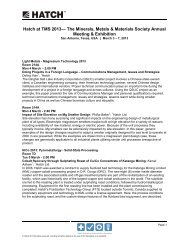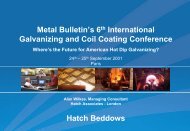Sustainable Development Report 2010 [pdf, 2.13 MB] - Hatch
Sustainable Development Report 2010 [pdf, 2.13 MB] - Hatch
Sustainable Development Report 2010 [pdf, 2.13 MB] - Hatch
Create successful ePaper yourself
Turn your PDF publications into a flip-book with our unique Google optimized e-Paper software.
has been appointed as one of only two EPCM<br />
consultants participating in ASAP, and <strong>Hatch</strong>’s<br />
representatives are also part of the project steering<br />
committee. This project is comprised of three<br />
development phases with the objective being a<br />
3,000-tonnes per day injection facility.<br />
The project is examining the technical, economic<br />
and public policy issues surrounding<br />
underground sequestration of CO 2<br />
. ASAP is the<br />
first project of its kind in Canada, and will play<br />
a major role in advancing industry and government<br />
knowledge of CO 2<br />
sequestration. Other<br />
members of the ASAP group include ATCO<br />
Power, BP Canada, Chevron, ConocoPhillips,<br />
Enbridge Inc, EnCana, EPCOR, TransCanada and<br />
UTS Energy Corporation, among others.<br />
bitumen production<br />
solvent injection<br />
N-Solv — <strong>Sustainable</strong> <strong>Development</strong><br />
Technology for Oil Sands<br />
<strong>Hatch</strong>, Nenninger, and Enbridge are developing<br />
a revolutionary method to extract bitumen in-situ<br />
from the Alberta oil sands — N-Solv. The underlying<br />
principle behind the process is the use of<br />
a recyclable solvent. Similar to steam-assisted<br />
gravity drainage (SAGD), heat is transferred from<br />
the working solvent to the bitumen reservoir.<br />
However, the use of a solvent negates the need<br />
for water, natural gas and resultant steam. N-Solv<br />
capitalizes on existing well recovery techniques<br />
while eliminating the need for ancillary equipment<br />
such as chemical water treatment and<br />
steam turbines.<br />
The use of a solvent is the most energy efficient<br />
method of injecting heat into a bitumen<br />
reservoir, offering significant opportunity for<br />
energy and cost savings in addition to a reduced<br />
environmental footprint per barrel of bitumen<br />
produced. N-Solv's carbon footprint is less<br />
than 1/7th that of currently practiced extraction<br />
techniques. In addition, bitumen produced<br />
carries a premium such that it leaves heavier<br />
hydrocarbons and ashphaltenes behind in the<br />
reservoir and does not suffer from upgrading<br />
losses. N-Solv is in the process of implementing<br />
a field pilot.<br />
Evergreen Line Rapid Transit Project —<br />
<strong>Sustainable</strong> Transport<br />
The Evergreen Line Rapid Transit Project is an<br />
11-km addition to Metro Vancouver's automated<br />
SkyTrain advanced light rapid transit system to<br />
connect the existing Millennium Line in Burnaby,<br />
British Columbia, to the northeast Metro<br />
Vancouver municipalities of Port Moody and<br />
Coquitlam.<br />
<br />
The N-solv process uses no water and 85% less energy<br />
than steam-assisted gravity drainage<br />
The project will contribute to a net reduction in<br />
regional greenhouse gas emissions of 9.3 kilotonnes<br />
per year by 2021. Up to 70,000 travellers<br />
per day who rely on single-occupancy vehicles<br />
16 METALS • ENERGY • INFRASTRUCTURE


![Sustainable Development Report 2010 [pdf, 2.13 MB] - Hatch](https://img.yumpu.com/22183361/16/500x640/sustainable-development-report-2010-pdf-213-mb-hatch.jpg)
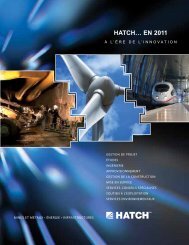
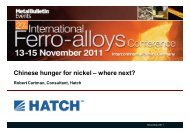
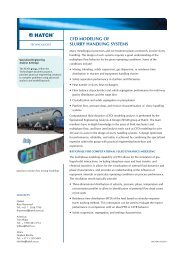
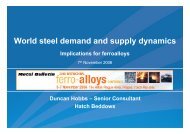

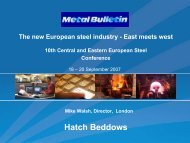

![Presentation: Global Overview of Line Pipe [pdf, 618 KB] - Hatch](https://img.yumpu.com/22183381/1/190x132/presentation-global-overview-of-line-pipe-pdf-618-kb-hatch.jpg?quality=85)
![This is Hatch 2011 - Our Organization [pdf, 636 KB]](https://img.yumpu.com/22183357/1/190x245/this-is-hatch-2011-our-organization-pdf-636-kb.jpg?quality=85)
![Annual Review - This is Hatch 2006 [pdf, 1.88 MB]](https://img.yumpu.com/22183355/1/190x245/annual-review-this-is-hatch-2006-pdf-188-mb.jpg?quality=85)
![Hatch Safety Report 2007 [pdf, 2.89 MB]](https://img.yumpu.com/22183353/1/190x245/hatch-safety-report-2007-pdf-289-mb.jpg?quality=85)
![Structural Assets Newsletter #16, October 2002 [pdf, 322 KB] - Hatch](https://img.yumpu.com/22183350/1/184x260/structural-assets-newsletter-16-october-2002-pdf-322-kb-hatch.jpg?quality=85)
